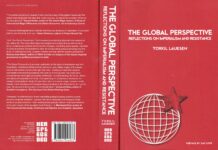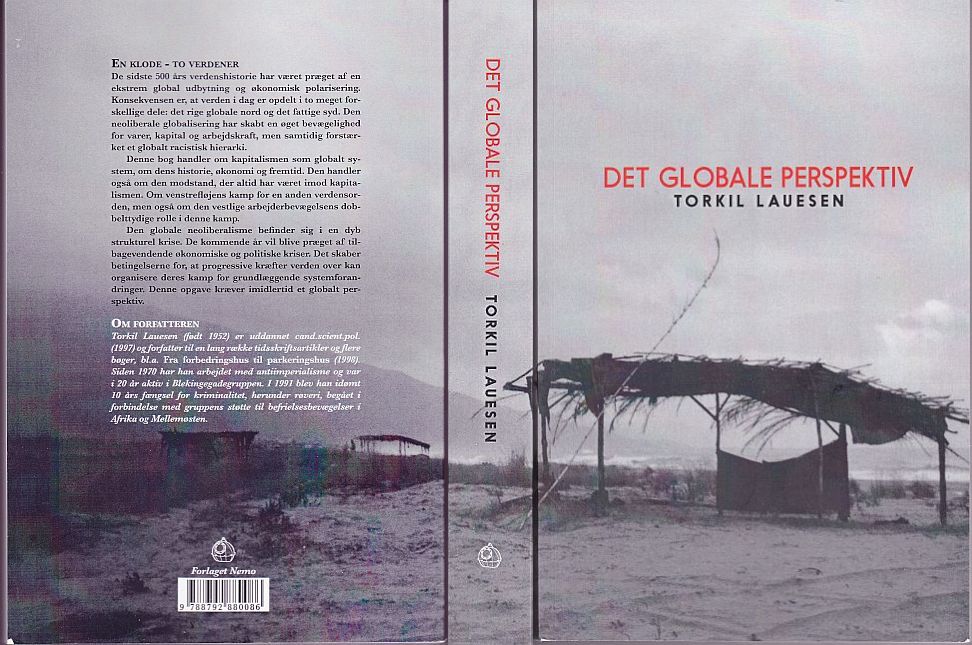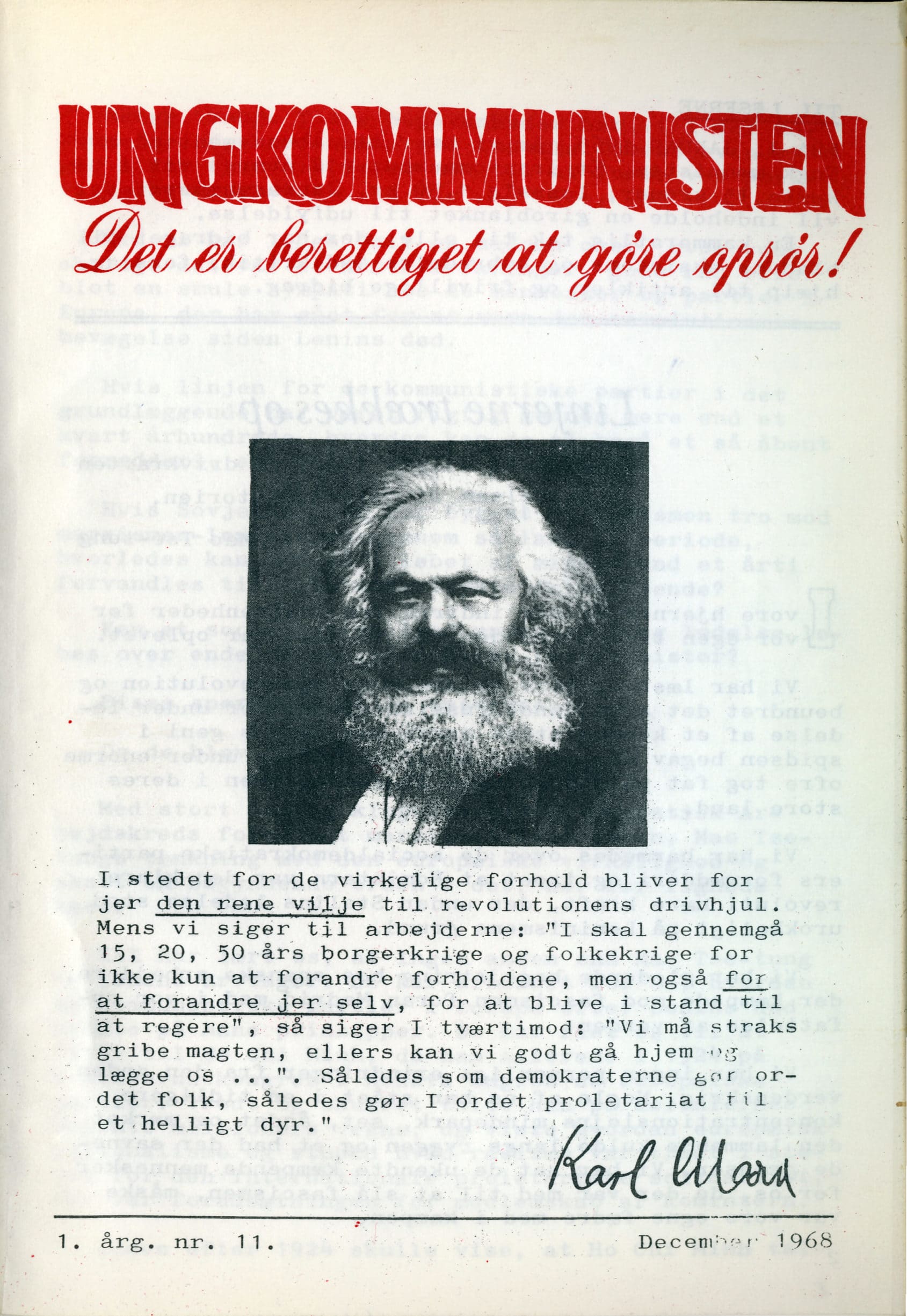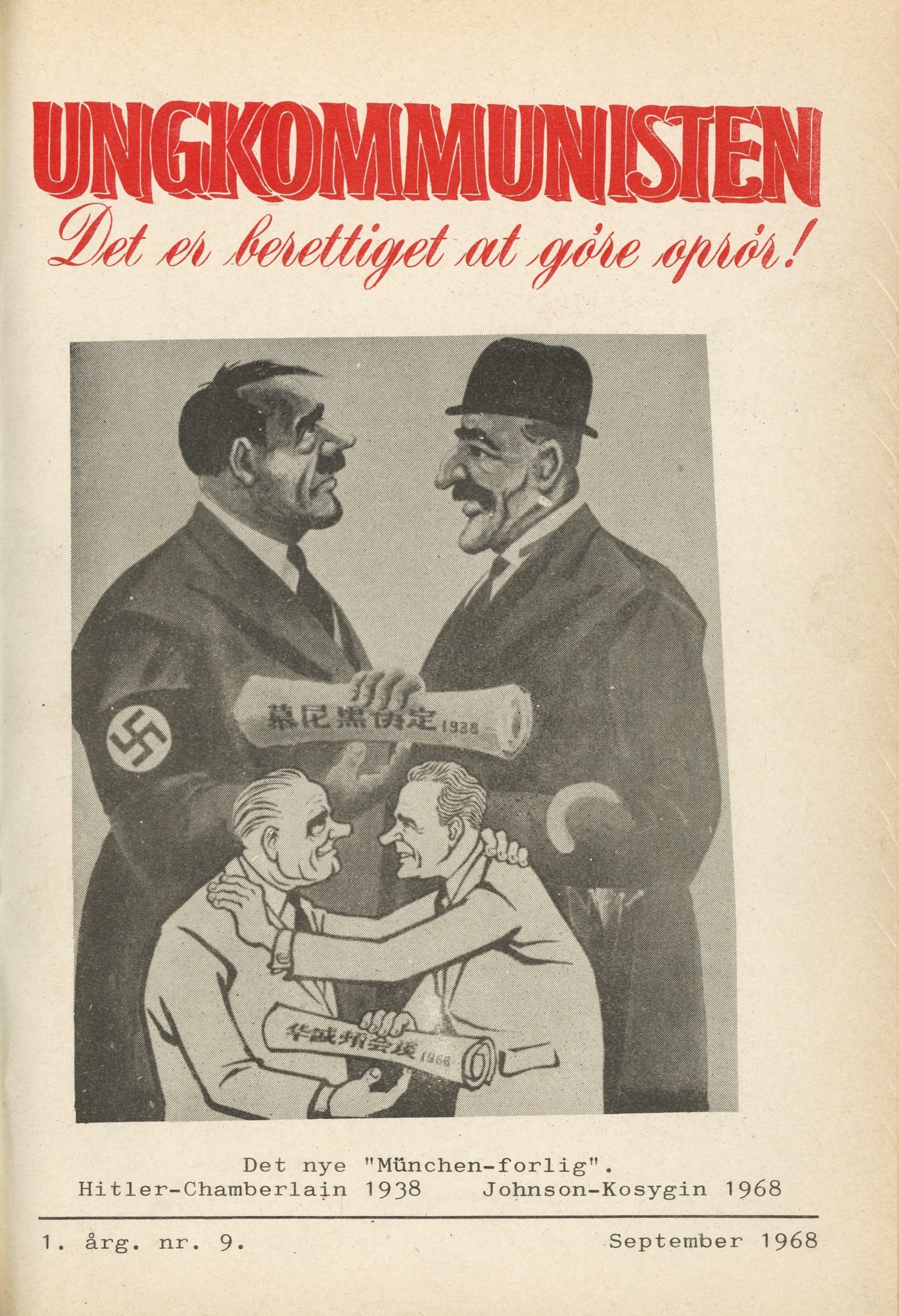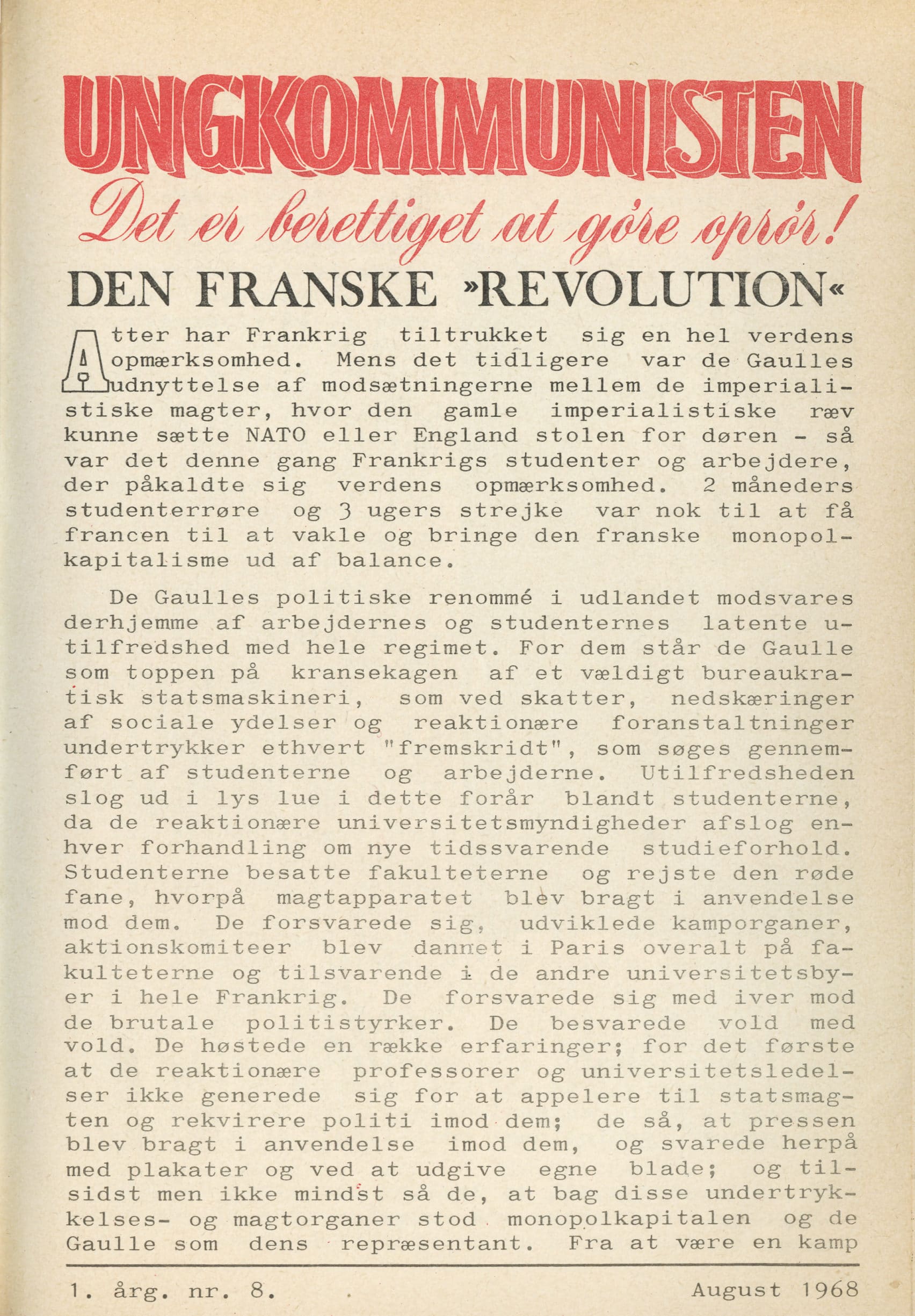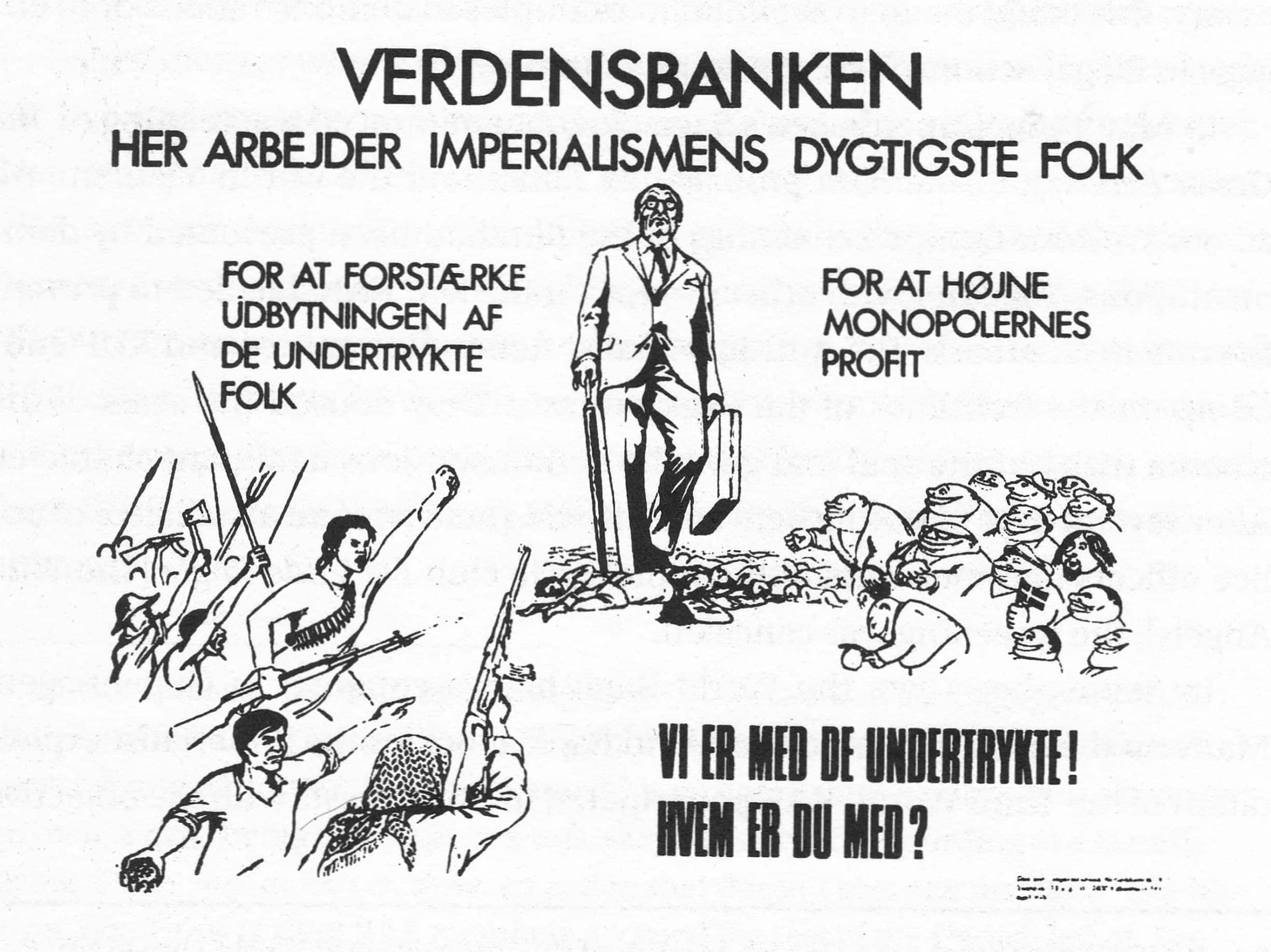About the text:
From: Communist Orientation No 1., April 10, 1975, p. 6-11.
Translated from Danish “Kommunistisk Orientering”, nr. 3, 24. februar 1975, s. 1-6.
Actually Gotfred Appel was not credited for the text either in the danish or the English edition – Only a few of his texts was credited to him.
The 3. part announced in the bottom of the text was never published – not even in Danish.
In No. 2 [Part 1, the online editor’s note] we traced the main lines of the development which – with Western and later on also Eastern capitalism as the motive force – made the world one integrated whole. We showed that from the time at which you can talk of one integrated process of development for the whole world, the principal contradiction on the various stages were to be found in the developed capitalist imperialist world. Finally we saw that at the end of World War II in August 1945, the principal contradiction of the world – that contradiction which determines and influences all other significant contradictions – was still to be found just there, in the imperialist part of the world. What has happened since 1945?
Enormous changes in the world since 1945
Let us first have a glance at the important historical events. Through the very battles of the war the countries of Eastern Europe were torn away from the control of French and German capitalism. During the following years they abolished the remnants of feudalism and towards the end of the 40’s they proclaimed themselves as people’s republics under the leadership of a communist party. India became independent in 1947. China succesfully carried through her War of Liberation and proclaimed herself a people’s republic in 1949 under the leadership of the communist party. Western Europe and USA formed the defensive alliance of NATO, USSR and the East European countries answered with the Warsaw Treaty Organisation. Germany was divided into two separate states. Korea was divided. Bloody wars were fought in Korea and in South East Asia. The Common Market was formed in 1958. De-colonization gathered momentum at the end of the 1950’s, and went on at some pace till the middle of the 1960’s. The 20th Congress of the Communist Party of the Soviet Union in 1956 marked the qualitative leap in the development of the Soviet Union away from socialism in the direction of an “ordinary” big power in the imperialist sense of the word. The Western and Eastern capitalist world experienced an industrial revolution of an unprecedented scale, an increase of productivity and of production of gigantic dimensions, and they gave their respective populations a material standard of living of which no one could even dream at the end of the war. China carried through her cultural revolution and thus cemented her internal possibilities of building socialism. While during the 1960’s the former colonies, now independent countries, in the main willingly allowed themselves to be plundered for raw materials and were passive victims of capital export and repatriation of profits, a new process is now under development, during which they build up manufacturing industries of their own and gain control over their ressources.
What about the principal contradiction in all this?
The US all dominating
During World War II the principal contradiction that determined and influenced all other in the least important contradictions in this world was to be found between two groups of countries at war. There can hardly be any doubt as to that.
Nevertheless, already during the war another contradiction began to emerge – or rather, a contradiction which had existed for a long time, but which had been relegated to an inferior position by the war, began to grow in importance towards the end of the war – i.e. the contradiction between imperialism and “socialism”, between the imperialist powers and the Soviet Union.
We know that Churchill wanted the armies of the western allies to get to Berlin before the Soviet ones in order to cut down the Soviet area of influence in Germany – and we know how the British army “liberated” Greece from Hitler-Germany, a liberation that took the form of fighting the Greek liberation forces and the setting up of a reactionary bourgeois regime. We know that Albania rejected attempts on the part of the British to carry out a similar “liberation” of Albania.
We know of contradictions inside the liberation movements of German occupied Europe between Western orientated people and communists – probably sharpest in Poland, where already during the occupation two groupings fought each other and where bloody skirmishes went on for many years after the war. And we know of the part played by the Polish government in London in the tragic revolt of Warsaw which was a part of the same game: An attempt, above all by the British, to limit Soviet influence in Eastern Europe – an expression of the contradiction imperialism – “socialism”.
(Let us explain why we write “socialism” with quotation marks, and in what sense we use the word. We use quotation marks, because the Soviet Union never was a socialist countries, but during the war a country on its way to socialism, and because to this day we have no socialist country in the world. [1] When using the word “socialism” we have in mind countries which under the leadership of a communist party have created or are striving to create a social order that makes it impossible or highly unsafe for the imperialist countries to export their capital to these countries make use of their raw materials and export their commodities to them on purely imperialist conditions.)
At the same time we have already seen that the independence of India in 1947 was a direct result of another contradiction – namely the contradiction between Great Britain and the US, between the US need for abolishment of the British imperial preferences and the British need to keep its colonial empire intact. The US were the dominating aspect in this contradiction. The immediate British need for military aid for the war against Germany was too great – the US got the upper hand, and India became an independent country (See the article on Famine in India in the present issue of C.O.).
In the reports from the various conferences in Teheran and Cairo during the war between the “three” and the “four” Great Powers we come across expressions of the same contradiction, and we note that, for instance, Stalin and Roosevelt agreed that gradually and over a longer period of time colonial regime ought to be replaced by independence for the colonial countries, an agreement directed first and foremost against France and Great Britain, but also against the other colonial powers among the allies.
During the post-war years now one, now the other of these two contradictions Seem to be dominating – now it is the contradiction imperialism – “socialism”, now the contradiction USA – the other victorious Western powers. One thing these two contradictions have in common: The US are playing the leading role in both of them.
De-colonization on American conditions
Which of the two that is the dominating contradiction at the various stages can be seen rather clearly from the process of de-colonization, which is one of the most important processes in post-war world development.
England was forced to give up her imperial preferences in India at a time, when the war was still on, and when the all-dominating contradiction was the contradiction between the two parties of the war.
That India actually became an independent state as the first big colony (after Egypt as early as the beginning of the 1920’s) was not due to a hard struggle for liberation in Hindustan, but to the fact that after World War II the US had emerged as the only strengthened imperialist power, and that the US wanted the colonial empires of the other imperialist powers abolished.
However, the US did not want colonial regimes abolished at any price, but under forms and with the establishment of regimes guaranteeing admittance for American capital to the formerly closed areas. USA did not want “socialism” in the former colonies, and in this USA were in full agreement with the old European colonial powers.
One other country had left the war militarily and politically strengthened – the Soviet Union had extended its influence to cover all those areas reached by her troops during the fight against Germany, and later against Japan. After the war it very soon became clear that the countries of Eastern Europe would remain under Soviet influence, and in the big European continental countries the weakening due to the war and the prestige of the communist parties from the liberation struggle against Hitler-Germany created a certain danger that they would develop in the direction of “socialism”.
During his stay in USA in 1947 Churchill started the cold war and drew down the iron curtain between East and West. To a great extent the Marshall Plan was launched in order to safeguard Western Europe against social states of affairs that might make it follow the example of Eastern Europe. During the first post-war years Europe was the main problem to USA – and among other things it was on this background that China succeeded in liberating herself from imperialism and from Chiang Kai-shek.
Imperialism versus “socialism” in East Asia
Mao Tse-tung has splendidly explained the situation:
“The U.S. policy of aggression has several targets. The three main targets are Europe, Asia and the Arnericas. China, the centre of gravity in Asia, is a large country with a population of 475 million; by seizing China, the United States would possess all of Asia. …
But in the first place, the American people and the peoples of the world do not want war. Secondly, the attention of the United States has largely been absorbed by the awakening of the peoples of Europe, by the rise of the People’s Democracies in Eastern Europe, and particularly the towering presence of the Soviet Union, this unprecedentedly powerful bulwark of peace bestriding Europe and Asia, and by its strong resistance to the U.S. policy of aggression. Thirdly, and this is most important, the Chinese people are awakened, and the armed forces and the organized strength of the people under the Ieadership of the Communist Party of China have become more powerful than ever before.” (“Farewell, Leighton Stuart”, Selected Works, vol. IV, p. 433-34).
USA had to give up what the government itself described as one of three possible ways regarding the situation in China, namely direct armed American intertervention at Chiang Kai-shek’s side, and to content itself with pouring money and weapons into Kuomintang’s armies. However, Kuomintang proved unable to cope with the task given it. The People’s Liberation Army won the war of liberation.
Decisive for us in this connection is the fact that the contradiction CPC-Kuomintang was allowed to find its solution mainly on the internal conditions of China herself without direct armed American intervention – in other words that this contradiction was influenced by the contradiction imperialism – “socialism”, USA – USSR, and more specifically by its European effects.
In other countries things developed in another way – although the possibilities seemed to be present because of this very contradiction imperialism – “socialism” and the contradiction between USA and the old colonial powers.
In part one of the present article we quoted Mao Tse-tung to the effect that it was only in China, a country under the indirect rule of imperialism and with struggles within the White regime, that it was possible during the thirties to set up Red base areas. In an editorial note to this article in Selected Works of Mao Tse-tung – first published in Chinese in 1951 – it says:
“Comrade Mao Tse-tung’s views on the question of establishing independent regimes in colonies under direct imperialist rule has changed. During World War II, many colonial countries in the East formerly under the imperialist rule of Britain, the United States, France and the Netherlands were occupied by the Japanese imperialists. Led by their Communist Parties, the masses of workers, peasants and urban petty bourgeoisie and members of the national bourgeoisie in these countries took advantage of the contradictions between the British, U.S., French and Dutch imperialists on the one hand and the Japanese imperialists on the other, organized a broad united front against fascist aggression, built anti-Japanese base areas and waged bitter guerilla warfare against the Japanese. Thus the political situation existing prior to World War II began to change. When the Japanese imperialists wire driven out of these countries at the end of World War II, the imperialists of the United States, Britain, France and the Netherlands attempted to restore their colonial rule, but, having built up armed forced of considerable strength during the anti-Japanese war, these colonial peoples refused to return to the old way of life. Moreover, the imperialist system all over the world was profoundly shaken because the Soviet Union had become strong, because all the imperialist powers, except the United States, had either been overthrown or weakened in the war, and finally because the imperialist front was breached in China by the victorious Chinese revolution. Thus, much as in China, it has become possible for the peoples of all, or at least some, of the colonial countries in the East to maintain big and small revolutionary base areas and revolutionary regimes over a long period of time, and to carry on long-term revolutionary wars in which to surround the cities from the countryside, and then gradually to advance to take the cities and win nation-wide victory.” (Selected Works, vol. I, p. 71).
Energetic efforts were made to do exactly this in the Far East. Indonesia declared its independence in August 1945, and during the years of Dutch colonial warfare maintained areas under Indonesian rule. Indo-China declared its independence, and when the French launched their colonial war, the popular armed forces first liberated the countryside before attacking the towns and cities. Guerilla warfare from revolutionary base areas was conducted against the British in Burma and Malaya. There was guerilla warfare against the Americans in the Philippines.
In later articles in “Communist Orientation” we are going to return to the phases of the process of de-colonization, but already now it seems manifest that the attitude of the US to these liberation struggles was influenced by two things: By the demand of American imperialism for this de-colonization – i.e. the contradiction between the US and the old colonial powers – and by the wish to see these new, independent states set up under regimes that fitted into the American economic, strategic and political aims i.e. the contradiction imperialism – “socialism”. The British conducted a barbaric colonial war against Malaya and were given full American support, because the Malayan liberation movement was communist led. In two or three waves the Dutch carried on a colonial war against Indonesia; but in 1949 they were forced – by the US – to give Indonesia her independence because Indonesia’s leader, Sukarno, and the political and economic objects of the independence movement were “acceptable”.
France conducted a colonial war in Indo-China and was given full American support, because the liberation movement was communist led. It is important to remember, however, that this American support was given on condition that, when the communists were beaten, France was to grant Indo-China her independence. (When France suffered defeat at Dien Bien Phu in 1954, the US intervened directly in Vietnam, because it was clear that if the Geneva agreements were honoured in full, the “communists” would win victory in the whole of Vietnam. Nixon terminated the direct American intervention in Vietnam, also because the contradiction imperialism – “socialism” is not what it used to be prior to the 20th Congress of the CPSU – but of that below.)
For a time the contradiction imperialism – “socialism” was dominating the scene, but the other one kept propping up. When this is at all possible, it is due to the fact that, as mentioned above, in both contradictions the US were playing the dominant role. In the contradiction imperialism – “socialism” the US constituted the most important element of the aspect “imperialism”, while in the contradiction US – old colonial powers the US were the dominating aspect.
De-colonization after the 20th congress
In the latter half of the 50’s decisive changes took place in the situation. First of all Western Europe and Japan were economically reconstructed (among other things tanks to the American Marshall aid, and also to the economic boom in the wake of the Korean war, 1950-53 – in other words under the influence of the contradiction imperialism – “socialism”). Concrete expressions of this we see in the establishment of the Common Market in 1958, and in de Gaulle’s energetic efforts to create a closer political-economic alliance between France and West Germany. This contains the embryo of a new contradiction, no longer a contradiction between the US and the other victorious colonial powers, but between the US and Western Europe, especially continental Western Europe.
Secondly, we had the qualitative leap in the development of the Soviet Union in connection with the 20th Congress in 1956 with its proclamation of “peaceful co-existence”, “peaceful competition” and “peaceful transition to socialism”. This meant the weakening of the contradiction imperialism – “socialism”, and rapidly it gave way to quite a new contradiction. The socialist camp ceases to exist. The very existence and the policy of the Soviet Union no longer helped create possibilities of liberation movements in the colonies of the kind mentioned by Mao. In the contradiction imperialism – “socialism” China alone constitutes one of the aspects, and the Soviet Union becomes one aspect in a new contradiction – between the super powers.
From the end of the 50’s to the middle of the 60’s de-colonization was really on the agenda, and in the majority of the countries it takes place without any hint of liberation movements, “communist” or not. A number of countries – Malagasy, Malaya for instance – whole “communist” liberation movements had been drowned in blood by the colonial powers, become independent during this period – but under quite different regimes, acceptable to imperialism, to the US. Special studies will be required to describe the reasons behind the specific development of, say, Algeria, where the liberation movement got into power, or in the Congo (Zaire) where independence was realized only after very hard struggler between forces representing the white settlers and forces representing various kinds of allegiance to foreign capital.
However, the absolute predominant feature of de-colonization in Africa is the fact that it takes place without liberation movements or with liberation movements, which did not really influence the creation of independent statehood. Thus once again the fate of the African colonies were being decided outside the colonies themselves – decided by contradictions in the imperialist camp, contradictions in the economy of the “mother country” and contradictions among imperialist powers, above all the US versus the other western powers.
CPC, the four fundamental contradictions – and CWC
At this juncture we experienced the great polemics between the CPSU and the CPC, which in its turn was the direct reason behind the formation of anti-revisionist parties and groups all over the world, among them CWC.
CWC was formed on the basis of the Chinese evaluation of the world situation, and we overlooked the fact that many of the things, which the CPC said in the polemics with the CPSU were aimed at bringing back the CPSU to a policy which it had already left. We took the Chinese’ words at their face value (and the Chinese did nothing to guide us or other groups, who acted the way we did), in stead of regarding them partly as an expression of an effort to stop the Soviet development.
Thus we took the Chinese “Proposal concerning the general line of the International Communist Movement” of June 14th, 1963, to our hearts and took the correctness of the following statement for granted:
“What are the fundamental contradictions in the contemporary world? Marxists-Leninists consistently hold that they are:
the contradiction between the socialist camp and the imperialist camp,
the contradiction between the proletariat and the bourgeoisie in the capitalist countries, the contradiction between the oppressed nations and imperialism, and
the contradictions among imperialist countries and among monopoly capitalist groups.”
When this was written, however, the socialist camp had already ceased to exist – the Chinese knew that better than anyone else. Nevertheless, they made the contradiction between the socialist and the imperialist camp no. 1 of the four fundamental contradictions in the world – because their “proposal” was aimed against the Soviet theses concerning peaceful co-existence and peaceful competition. It was an “ideological” polemics. In reality, already then the Soviet Union had destroyed the socialist camp, and in reality, therefore, the contradiction had disappeared.
Furthermore, we allowed ourselves to have our view of the world dictated by the following from point (8) of the same “proposal”:
“The various types of contradictions in the contemporary world are concentrated in the vast areas of Asia, Africa and Latin America; these are the most vulnerable areas under imperialist rule and the stormcentres of world revolution dealing direct blows at imperialism.
The national democratic revolutionary movement in these areas and the international socialist revolutionary are the two great historical current of our time.
The national democratic revolution in these areas is an important component of the contemporary proletarian world revolution.
The anti-imperialist revolutionary struggles of the people in Asia, Africa and Latin America are pounding and undermining the foundations of the rule of imperialism and colonialism, old and new, and are now a mighty force in defence of world peace.
In a sense therefore the whole cause of the international proletarian revolution hinges on the outcome of the revolutionary struggles of the people of these areas, who constitute the overwhelming majority of the world’s population.”
We took these words and evaluations to our hearts, made them our own words and evaluations and acted on the basis of them.
At the 9th Congress in 1969 the Chinese changed the formulation of their four fundamental contradictions in the world to-day. In the report to the Congress it says:
“… there are four major contradictions in the world today: The contradiction between the oppressed nations on the one hand and imperialism and socialimperialism on the other; the contradiction between the proletariat and the bourgeoisie in the capitalist and revisionist countries; the contradiction between imperialist and social-imperialist countries and among the imperialist countries; and the contradiction between socialist countries on the one hand and imperialism and social-imperialism on the other.”
The contradiction between the oppressed nations and imperialism has become contradiction no. 1 in stead of no. 3, and the aspect “imperialism” has been extended to comprise also “social imperialism”, i.e. the Soviet Union. The contradictions among monopoly capitalist groups have disappeared.
Why as late as 1969 the Chinese still stick to this picture of the world – in spite of facts, now evident also to us – remains a riddle, and again the decisive thing is that we in CWC believed in it, made the picture our own and acted on the basis of it – with the not unimportant exception, however, that we flatly refused to regard the contradiction between the proletariat and the bourgeoisie in the imperialist countries as a contradiction playing any essentiel role for the time being.
Vietnam and US – USSR
Under the impression of the Vietnam war and under the impression of the Palestinians’ struggle against Zionism and Arabian reaction we (as mentioned in article 1) in 1970 formulated the principal contradiction in the world as the contradiction between the neo-colonially oppressed people and imperialism.
We did so in order thereby to give expression to the idea that – as was said in the “proposal” – the anti-imperialist struggle in the former and present colonies and dependent countries was the only force that might undermine, and which was actually undermining the foundations of imperialism, thereby creating the pre-conditions of the emergence of a revolutionary situation in the imperialist countries.
Subsequent, independent studies have revealed to us that this “anti-imperialist national revolutionary democratic” movement in Asia, Africa and Latin America simply did not exist during the 1960’s and to-day does not exist on a scale that makes the statement concerning the principal contradiction in the world true to facts.
Other things constituted the motive force during the 1960’s – the contradiction USA-Europe and the contradiction USA-USSR.
The latter is probably playing the main part in the Vietnam war, for instance, from the time of the first American bombardments of North Vietnam in August, 1964 (while in its turn the Vietnam war played a tremendous role for the economic development in all capitalist countries during the same period).
The Vietnam war merits much closer studies. But it is undoubtedly true that the US escalation of the war, especially since February, 1965, is very closely related to the Soviet 180 degree turn in relation to Vietnam.
As will be remembered, Chruschow totally ignored the war in South Vietnam, and only Kosygin – his successor as prime minister – brought the Soviet Union into the picture.
He visited Vietnam in February, 1965, at a time when the Soviet Union had already established itself as an “ordinary” big power, i .e. at a time when the contradiction imperialism – “socialism” in the sense of a contradiction primarily between USA and USSR had been replaced by the contradiction USA-USSR in their capacity of big powers with big power interests.
This means that the policy for which the Soviet Union was working through its intervention in the Vietnam war – its military aid, its political activity – was not aimed at guaranteeing a “socialist” regime in the whole of Vietnam, but was aimed at keeping North Vietnam within the orbit of Soviet influence and letting the US decide the form and contents of independence in South Vietnam.
As happened elsewhere (the Cuban crisis, the Middle East) the contradiction USA-USSR found ex-pression partly in Soviet capitulation, partly in competition between the two countries in their efforts to keep their own spheres of influence and to nibble at those of the counterpart.
Within this framework the last phase of the Vietman war (until the Paris agreements) were fought. This contradiction determined and influenced the other contradictions in both South and North Vietnam, and within both the Liberation Front and the Saigon regime. The present, tragic situation in South Vietnam, semi-war and semi-peace, is precisely the result of the influence on the internal Vietnamese contradictions from this external contradiction. Neither of the parties – neither the US nor the Soviet Union – succeeded completely in making “their” people dance to their respective tune, but their influence has been big enough to sow destruction and create uncertainty, misery and chaos.
Struggle around the US dollar
While the Vietnam war was still raging, the other one of the two most important contradictions came to the fore – the contradiction USA-Europe(Japan).
The two contradictions are there the whole time, their respective weight shifts from period to period, even from area to area.
Only thorough studies can tell us which of the two is the most important at a given time and place. Does the sharpening of the contradiction USA-Europe during the late 1960’s influence the contradiction USA-USSR, or is the latter retarding the effect of the former?
This is not so very important for our present purpose. Here it must suffice to state that as a result of the economic development, including the weakening of the US because of the Vietnam war, Europe – above all the countries of the Common Market, and within that again above all France – launched a crusade against the US gold stocks and against the dominant position of the US dollar in the western world.
It was a crusade with far-reaching effects on foreign exchange relations, on international finance, on economic life not only in Europe and the US, but in the whole world (China may have a special position in this respect).
Ironically enough, the youth revolt in May, 1968, in France, with its strikes and occupations of factories played a decisive role in stopping the French assault on the US dollar. However, the contradiction remained. A general foreign exchange crisis was the result – also of the relative strengthening of Western Europe and Japan vis a vis the US.
(It was also under the impression of the sharpening of this contradiction that Nixon put an end to the direct American military involvement in Vietnam)
The Third World in the centre once again
The struggle within the imperialist world was not only conducted in the field of foreign exchange. The competition for markets, for raw materials among the national or multinational companies of the various countries in both the Third World and in the Soviet Union and Eastern Europe had been sharpened ever since the transition of the Soviet Union to a capitalist economy, and since de-colonization.
Together with foreign exchange crisis and inflation in the Western world, together with economic difficulties everywhere in the old and new capitalist countries in the East and in the West, during the 70’s we experience a new economic and political development in the Third World.
OPEC, the organisation of the oil exporting countries, is sharpening its price and supply policies in relation to the big western oil companies. Other raw material producing countries, supplying for instance bauxite, cobber or sugar, form organisations to look after their common interests in relation to the industrialized world.
A wave of nationalizations of the property of western companies is sweeping the Third World – from Iran to Peru, from Zaire to Saudi Arabia – above all the property of raw material producing companies.
A wave of industrialization is sweeping the Third World. Protected by new internal power, in step with the nationalizations, a market economy, based on capitalist agriculture and on an ever bigger manufacturing industry, is growing up – from Iran to Peru, from Zaire to Saudi Arabia and Brazil.
What is happening? Whom does the Shah of Iran represent, whom do the generals of Peru represent? Whom does Mobuto of Zaire represent?
Is it a new national bourgeoisie? Are the new structures of power growing on the basis of the initial national industrialization? Or is it the other way round?
Is industrialization taking shape on the conditions of western and eastern industrial nations, or do we see an “inherent” tendency towards independence in the Third World? Is the growing manufacturing industry a new expression of competition – a new contradiction – in the industrialized world, a contradiction between raw material producing industry and manufacturing industry?
These problems and problems in connection with the present Chinese formulation of the main trend in world development – “Countries want independence, nations want liberation, people want revolution” – will be dealt with in the third article in this series.
(No. 3)
Note:
- See: Gotfred Appel: The Devious Roads of the Revolution, Futura, 1972.[↩]
Om forfatteren / About the Writer
Gotfred Appel, Formand og ideologisk leder af Kommunistisk Arbejdskreds fra 1964 til splittelsen i 1978. Gotfred Appel fortsatte sammen med Ulla Houton under navnet Kommunistisk Arbejdskreds, KAK.
Gotfred Appel, Chairperson and ideological leader of the Danish Kommunistisk Arbejdskreds, KAK (Communist Working Circle, CWC) from 1964 till the splitt in 1978. Gotfred Appel continuned with Ulla Houton as Kommunistisk Arbejdskreds, KAK.



